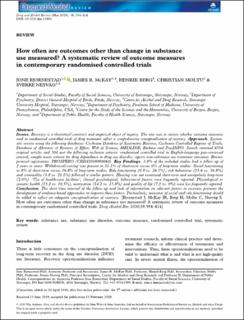| dc.contributor.author | Bjørnestad, Jone Ravndal | |
| dc.contributor.author | McKay, James R. | |
| dc.contributor.author | Berg, Henrik | |
| dc.contributor.author | Moltu, Christian | |
| dc.contributor.author | Nesvåg, Sverre Martin | |
| dc.date.accessioned | 2023-01-16T12:34:43Z | |
| dc.date.available | 2023-01-16T12:34:43Z | |
| dc.date.created | 2020-03-16T17:12:35Z | |
| dc.date.issued | 2020 | |
| dc.identifier.citation | Bjornestad, J., McKay, J. R., Berg, H., Moltu, C., & Nesvåg, S. (2020). How often are outcomes other than change in substance use measured? A systematic review of outcome measures in contemporary randomised controlled trials. Drug and Alcohol Review, 39(4), 394-414. | en_US |
| dc.identifier.issn | 0959-5236 | |
| dc.identifier.uri | https://hdl.handle.net/11250/3043725 | |
| dc.description.abstract | Issues
Recovery is a theoretical construct and empirical object of inquiry. The aim was to review whether outcome measures used in randomised controlled trials of drug treatment reflect a comprehensive conceptualisation of recovery.
Approach
Systematic review using the following databases: Cochrane Database of Systematic Reviews, Cochrane Controlled Register of Trials, Database of Abstracts of Reviews of Effect, Web of Science, MEDLINE, Embase and PsycINFO. Search returned 6556 original articles and 504 met the following inclusion criteria: randomised controlled trial in English-language peer-reviewed journal; sample meets criteria for drug dependence or drug use disorder; reports non-substance use treatment outcomes. Review protocol registration: PROSPERO (CRD42018090064).
Key Findings
3.8% of the included studies had a follow up of 2 years or more. Withdrawal/craving was present in 31.1% of short-term versus 0% of long-term studies. Social functioning in 8% of short-term versus 36.8% of long-term studies. Role functioning (0.9 vs. 26.3%), risk behaviour (15.6 vs. 36.8%) and criminality (3.8 vs. 21.1%) followed a similar pattern. Housing was not examined short-term and unregularly long-term (2.0%). ‘Use of health-care facilities’, clinical psychological, behavioural factors were frequently reported. Physiological or somatic health (15.2 vs. 10.5%), motivation (14.2 vs. 15.8%) and quality of life (7.1 vs. 0%) were less frequently reported.
Conclusion
The short time interval of the follow up and lack of information on relevant factors in recovery prevents the development of evidence-based approaches to improve these factors. Particularly, measures of social and role functioning should be added to reflect an adequate conceptualisation of recovery. | en_US |
| dc.language.iso | eng | en_US |
| dc.publisher | John Wiley & Sons | en_US |
| dc.rights | Navngivelse 4.0 Internasjonal | * |
| dc.rights.uri | http://creativecommons.org/licenses/by/4.0/deed.no | * |
| dc.title | How often are outcomes other than change in substance use measured? A systematic review of outcome measures in contemporary randomised controlled trials | en_US |
| dc.type | Peer reviewed | en_US |
| dc.type | Journal article | en_US |
| dc.description.version | publishedVersion | en_US |
| dc.rights.holder | the authors | en_US |
| dc.subject.nsi | VDP::Medisinske Fag: 700::Helsefag: 800 | en_US |
| dc.source.pagenumber | 394-414 | en_US |
| dc.source.volume | 39 | en_US |
| dc.source.journal | Drug and Alcohol Review | en_US |
| dc.source.issue | 4 | en_US |
| dc.identifier.doi | 10.1111/dar.13051 | |
| dc.identifier.cristin | 1801904 | |
| cristin.ispublished | true | |
| cristin.fulltext | original | |
| cristin.fulltext | original | |
| cristin.qualitycode | 1 | |

